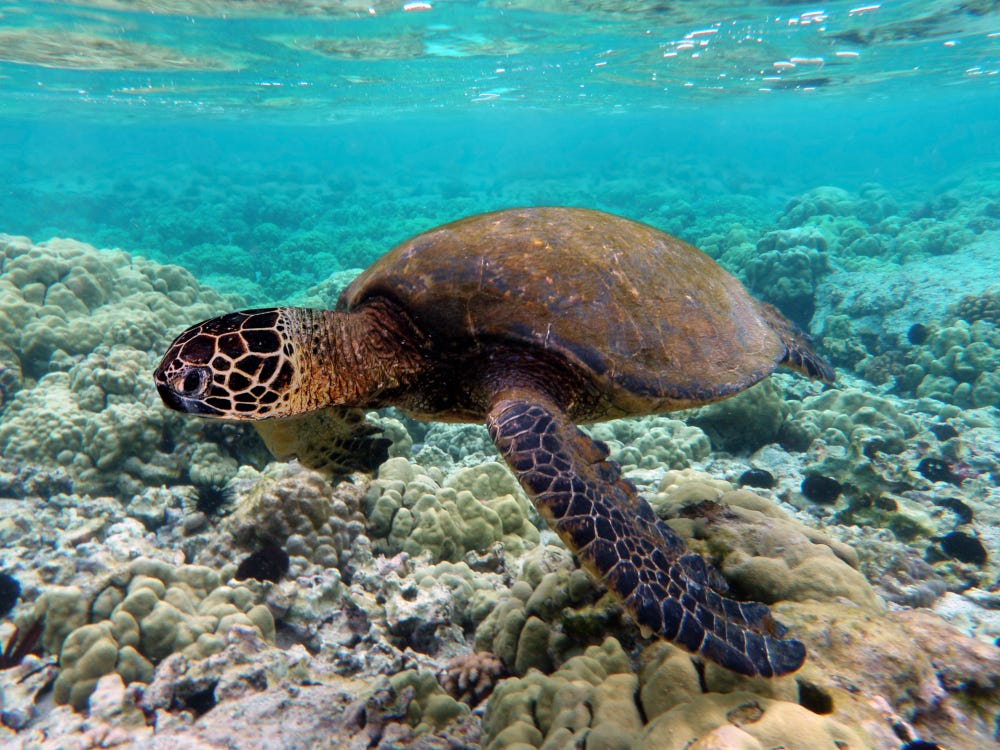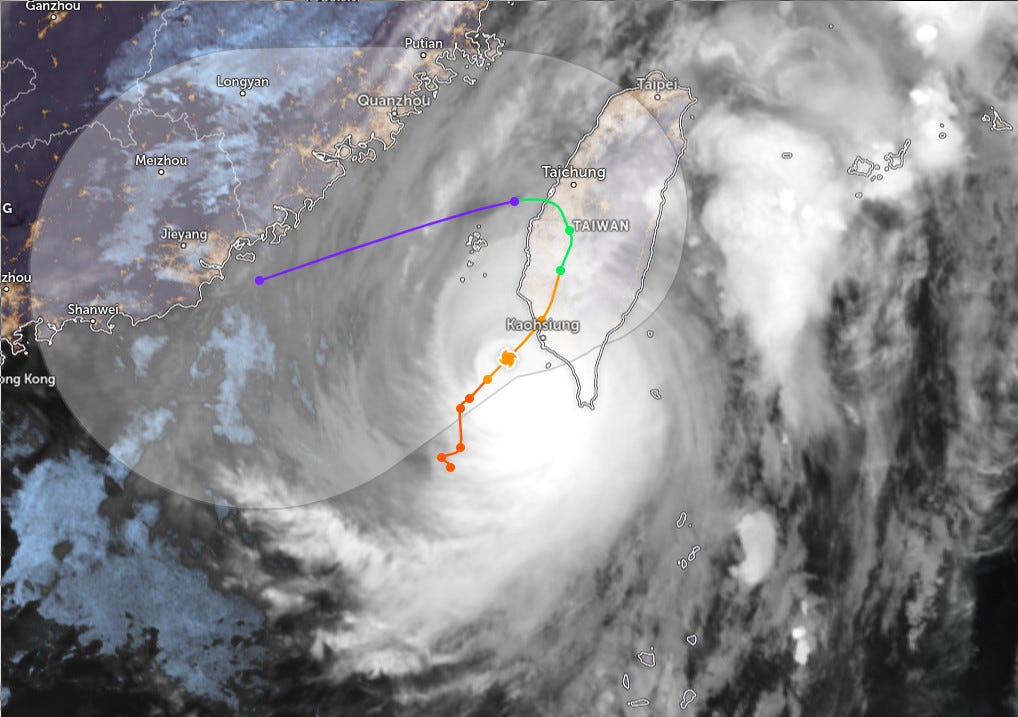Welcome to the November issue of the Peripatetic Historian.
This Month:
Peripatetic Field Report: Sea Turtles and Scooters
Book News
What’s New in Old News?
Here One Comes Again—A Typhoon Tale
Let’s get started…
Sea Turtles and Scooters
October carried your faithful foreign correspondent from one end of Taiwan to the other. A two-hour high speed rail journey covers the 300 km from Taipei (at the northern tip of the island) to Kaohsiung, the southernmost population center. After a pleasant overnight stay in Kaohsiung, Mary and I caught a ferry at Donggang and sped across the Strait of Taiwan.
Our destination was Xiaoliuqiu, a pinprick of an island, the product of relentless coral growth. Roughly 4.5 km long and 2 km across at its widest point, the island serves as a vacation resort and home base for a large colony of sea turtles.
When I first turned my attention to the problem of decoding the island’s name, I theorized that liuqiu meant “turtle,” which would make Xiaoliuqiu “little turtle island.” I was, as is often the case, completely wrong. Based on my dictionary digging, liuqiu is a reference to Japan’s Ryukyu island chain—of which Okinawa is the most famous member.
Arriving visitors tend to rent two items upon reaching the island: diving gear and motor-scooters. Since many Taiwanese don’t swim, scooters bring the greatest cash infusion to the local economy. Guests, rolling off the ferry in incoming waves, crash over a breakwater of scooters. A dark double-line of parked scooters fill both sides of the street, monopolizing the space once reserved for foot traffic. Scooter touts mob arriving visitors, waving brochures and contracts.
Most people—myself excluded—succumb. Completed paperwork and cash deposits are exchanged for scooter keys. Set free to roam, scooter herds careen through narrow, pedestrian-choked lanes, racing with throttles twisted open, heedless of life, limb, or consequences.
The majority of riders occupy a narrow demographic: late teens, early college. Young men, in love with the snarl of a 50 hp engine, gun through the riotous obstacle course; girls in cropped shorts and bikini tops ride pillion. I could see the scene being used in a remake of American Graffiti—Taiwan Graffiti, the tale of a lost scooter generation.
When not menacing pedestrians, riders park their machines on the sidewalk, forcing peripatetic folk out into the street. Walkers intersperse with motor scooters, a situation that would suggest the need for slow and careful driving.
But that’s no fun.
Far better to twist the throttle and hurl your machine at the traffic in front of you. During the busy hours, Xioaliuqiu resembles the running of the bulls during San Fermin de Pamplona—only slightly more dangerous. Rare is the day that expires without the wail of a siren as a victim—either rider or pedestrian—wins an ambulance trip back to the mainland.
Xiaoliuqiu—where even the Grim Reaper walks warily in the streets.
Let us leave this tale of mayhem and carnage and return to the serene world of the sea turtle.
Xiaoliuqiu is Taiwan’s only coral island. Thousands of years of the ocean jack-hammering the reefs have produced a chunky white coral sand. After renting snorkels and fins, we walked down the sloping beach at Vase Rock, slithered through a surf that wanted to knock us against the coral walls, and then kicked out into the tungsten blue water that lies immediately offshore.
My eagle-eyed wife spotted our first turtle. It was a small specimen, wedged into a niche between two rocks. Slowly, methodically, it grazed its miniature pasture, tearing up patches of sea grass.
The majority of turtles around the island are Green Sea Turtles. Like most turtles they embrace a carnivorous diet in their early years, snapping up jelly fish, eggs, and other high protein delicacies. As they age, they grow concerned about cholesterol and adopt vegetarian lifestyles. The trimming of underwater sea grass offer Sea Turtles an important role in the cleaning and tending our ocean reefs.
The thing that surprised me the most about these critters—and we spent a couple of hours breathing through plastic tubes in order to watch them—is how long they can stay underwater before they need to surface. I figured that a turtle might be able to stay down for a minute or two, but they can go for more than five minutes between breaths when feeding or swimming. They sleep underwater and in this state of reduced activity, their submerged time can extend several hours.
When the turtle wants to breathe, he floats to the surface, raises his neck like a periscope, and expels the air from his lungs. A quick gasp and back down he goes, primed for another leisurely chew among the coral branches.
Swimming with the turtles—and we saw dozens—was magnificent. We felt deep regret when our two-night stay came to an end. With heavy hearts we dodged motor scooters all the way back to the waterfront and caught our returning ferry.
Book News
California History Podcast
I sat down with Jordan Mattox in late September to talk about LA Birdmen. Here’s that podcast if you wanted to tune in:
October in What’s New in Old News
Four new exciting episodes this month:
Duel with a Devilfish
Deep sea diver Martin Lund got more than he expected while working to raise the wreck of the steamship Pomona. Could he survive his battle with a monstrous devilfish?
Like a Spider in a Web
Edward Wieren’s cunning plan to steal his company’s payroll runs into a snag when he is inadvertently locked in the safe.
The 4,000 Foot Death Plunge
Readers of Comet Madness may remember A. Holland Forbes, the balloonist who fell from the sky while chasing Halley’s Comet. That wasn’t his first catastrophic accident.
Detective Priest Battles Anarchist
Crime-fighting clergy aren’t that common in the harsh streets of the real world. Nevertheless, Father J. K. Fielding was ready when an anarchist attempted to put a bullet in his chest.
Here One Comes Again:
I feel as if I’m a character in Bill Murray’s Groundhog Day. You will recall that last month the newsletter ended with Typhoon Krathon about to storm ashore and wreak havoc in Taiwan. Well, after keeping us in suspense until well after the newsletter was published, the typhoon rolled over Xiaoliuqiu and made landfall near Kaohsiung.
On the morning of October 3, with winds hitting 220 Km/Hr (136 mph), Krathon clawed the island. It looked like this just before it struck:
Forecast models disagreed about what would happen after it touched land. Some believed that it would turn west; others predicted the eye of the typhoon would track up the island and strike Taipei.
The direction was right, but no one expected what actually happened. Here is a satellite image from 24 hours later:
Where did it go?
As it turned out Taiwan’s hard stone mountains ripped the heart out of the storm. Within 24 hours of making landfall, the clouds dissipated and Category Three winds collapsed into the random breezes of a typical gusty day.
The storm died quickly but not quietly: it killed four people and injured 700. It ripped roofs from buildings and shredded exposed surfaces. Jinshan District on the northern end of the island received 24.6 inches of rain in 24 hours.
Kaohsiung bore the brunt of the storm. The most obvious damage, when I visited the city two weeks after the blast, was sheet metal roofing twisted like a wood shavings, canvas awnings that appeared to have been shredded by giant cats, and groves of downed trees browning beneath the tropical sun. Sundered limbs littered the parks, snapped from the trees as if Paul Bunyan had run an over-sized weed whacker across the city.
Whither the Groundhog?
My sense of deja vu is inspired by the fact that as I finish this month’s installment of the Peripatetic Historian, Typhoon Kong-rey (aka Leon) is approaching Taiwan. It should arrive about the time this drops into your email box—just like last month.
Scary, eh?
You just never quite know what’s coming next. But until it arrives, be safe, be sensible,
This newsletter was designed to be passed along to a friend. Hit the share button and send a copy to someone else who might find it interesting.
Thoughts? Comments? I have a button for that as well:









The trip to Green turtle coral reef sounded like a blast. It sounds like you have a secure apartment in Taipei to weather the rain and wind. Stay safe—I know you are sensible!